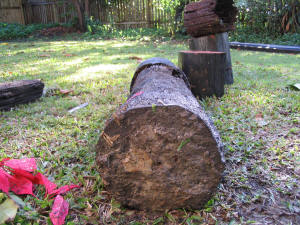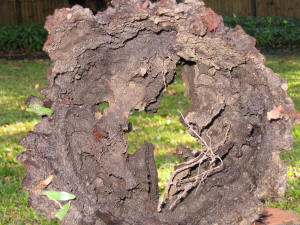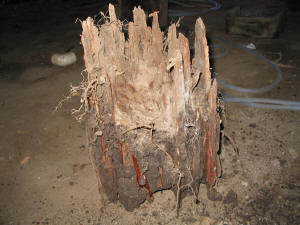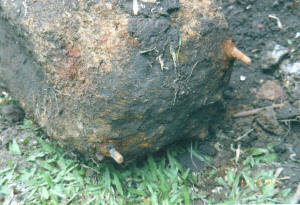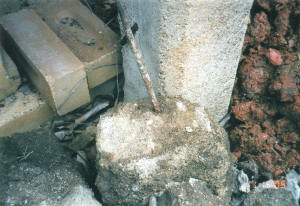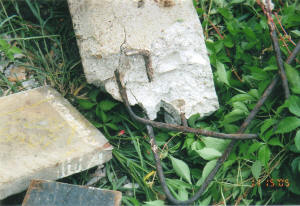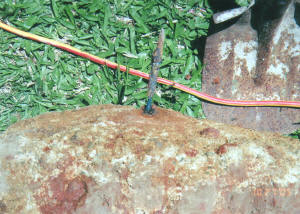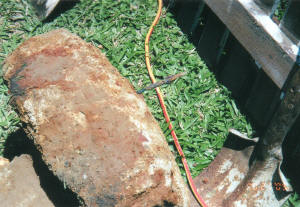What causes timber stumps to sink?
Most people think that when windows or doors will not close properly and the house seems to be on a ‘bit of a tilt’, or the floors seem to be uneven to walk on, that it is the house ‘settling’…Phone calls to house re-stumpers are made to obtain quotes to pack and re-level the wooden house stumps to correct the problem and make the home level again.
This is nothing but a waste of time and your money when timber stumps are involved! I know only too well, that there are many re-stumping contractors who will come out and charge you good money to pack wood stumps back to level, knowing full well that the stump/s will sink again, within a short period of time and they will be called out to do the packing again for you – not telling you what the real problem causing the timber house stumps to sink.
If timber house stumps sink, there are causes and reasons as to why this has happened.
The most common cause of a wooden house stump to sink is;
1. Termite damage.
At the bottom of this stump (images below), which was once a round solid wooden stump, is now little more than a hollow shell where the termites have eaten a very large deep hole into the bottom. This caused the stump to become unstable, allowing the weight of the home over that stump, to push it down into the dirt below.
This hole made by the termites allowed the dirt to be PUSHED UP, inside the middle of the stump – See the bottom of the stump with the mud pushed inside of it?
- Termite Damage
- Termite Damage
After the stump was hosed off and cleaned up, we then used a chainsaw to cut it, showing you the full extent of damage done by the termites. This is WHY it is practically impossible to pack or repack a wooden stump that has sunk and why it is silly to pay out good money to have a stump packed when it really should be replaced in the first place.
Packing wood house stumps may be a relatively cheap alternative to the replacement of a stump, but knowing what you do now; would you still pack a lose or sunken stump? OR would you replace it saving money? For once replaced, it will never have to be done again, and you will not have to be on the phone to a house re-stumper every couple of months to repack the problem.
If a house re-stumper tells you that packing a wooden house stump is “ok to do” and re-levelling it will fix the problem, and that “you will have no more trouble with it”, DO NOT believe him!
How would he know in the first place, unless he has x-ray vision and can see into the ground, the condition of the bottom of a wooden house stump? HOW is it possible to pack and level something that is hollow? (As the photo above shows)
Ask yourself, if your boat had a hole in it, would it still float? No, it will sink, just like a wooden house stump will do. It will sink again and faster in rainy weather, as water will sink into the ground causing the dirt under the stump to turn to very wet mud, thus combined with the weight of the house over that stump, the mud will be pushed upwards INTO the hole made by termites!
Question : Is it legal to pack wood or concrete house stumps?
Answer : Yes, it is, but, by law only up to and not exceeding 50mm (2 inches).
IT IS ILLEGAL to pack over 50mm (by building code law) and all offending house stumps; concrete, wood or steel columns lower than 55mm must not be packed and must be replaced.
The second most common cause of a wooden house stump to sink is;
2. ‘Dry rot’
This is where the lower part of the stump rots away, leaving two sections of stump in the ground and a big gap between both parts of the top and bottom half, causing the top half to sink away from the home, leaving a gap and the stump can be moved with ease.
Another common cause of dry rot in a wooden house stump, is when the stump is replaced and concrete is used to fill the stump hole first, before the new wooden stump is installed. When concrete is laid, it will suck in and hold moisture. The new wooden stump is dry, and we all know that timber will also suck in and retain moisture; therefore speeding up the process of rotting the new stump.
Note the tree roots in this scenario? A garden was built up against this stump. Watering the garden on a very regular basis, played a big part in the rotting of this stump…
The third most common causes of a wood or concrete stump to sink is;
3. The soil itself
Reactive clay soils, as well as houses built on old flood plains.
Brisbane has quite a few areas like this, such as; Rocklea, Acacia Ridge, Stones Corner, Anstead & Pullenvale – just to name a few…
In the early days from the 1920’s and now days as Brisbane grows, more land is needed to be developed for housing and much dirt is dumped and used as land fill to fill up old water holes, creeks and gullies, as well as flood plains and this was done all over Brisbane in many suburbs, thus causing some homes in some areas after a time, to start moving. This causes house stumps to sink and it’s due to this sinkage in the soil, that some areas in Brisbane have what is called ‘black soil’; very much like the soil in Ipswich. This soil is very reactive and a lot of movement does occur when it rains, as the soil swells. When the weather is dry, the soil will sink and small to large cracks will appear in the ground. Areas such as this, should be avoided if you’re looking to buy a home. To find these areas, refer to old maps of Brisbane which the B.C.C. town planning should have on hand that you can use as reference.
What causes concrete stumps to crack or ‘blow-out’?
There are many reasons as to why a concrete stump cracks – the most common causes are as follows;
Before we had ‘recycling’ (as we do now), all concrete was dumped. Nowadays, it is usually sent to a recycling plant and crushed, where it is sold back to the trades’ people as ‘concrete blend’.
Gravel used to be dredged from the Brisbane River, but this activity was finally ceased, over ten years ago. Gravel sourced from this saltwater river, was sold at the time as ‘washed’ gravel. It was however ‘washed’ in the salt water from the River, then placed in wooden hoppers to be sold at a South Brisbane plant which has now also been demolished and a new plant constructed.
Most people know, that to make concrete stumps, you need sand, gavel, cement powder, steel reinforcing rods & water. Back in my dads day, all this was done by hand – the mixing of the concrete, the cutting of the steel rods with hack saws, and the stumps were made in square timber boxes…The problem was, that the gravel used then as explained, came out of salty water from the Brisbane River and when you added fresh water into the mix – this activated the salt! This in turn made the steel reinforcing rods (which were not galvanised back then and are still not galvanised today & should be!), start to form rust (oxidisation).
Also back in my fathers day, it was common practice if the steel reinforcing rods were cut too long, they were hammered into the ground below the top of the timber boxing, thus allowing rust to form – as back then, all concrete stumps were made on-site, in free standing timber boxes over the stump hole. Today, the concrete stumps are prefabricated in steel form work, laying flat.
Other causes for concrete stump cracking;
1. Lack of cement powder in the mix – during the depression after the war – many materials were hard to get, so being ‘thrifty’ back then, was common practice
2. Rusted steel reinforcing rods (shown below)
These photographs shows how the steel rod was pushed below the base of the concrete stump into the ground, where moisture was able to attack the steel rod, allowing the rusting process to begin…
You can see here, how the rust travels up the steel rod inside the concrete, making the steel rod double in size where it will cause cracking of the concrete stump.
When this occurs, the steel rods are then vulnerable to moisture, expediting the rusting process…
Large pieces of the concrete stump then crack and fall away, exposing the steel rods and allowing the elements to take hold, wreaking the stump and cutting short it’s effective life span.
Poor mixing will cause cracks too, as it all was done by hand back then, unlike today where it is all measured out, so there is no guesswork involved.
Damp soils will also cause old pre-war concrete house stumps to crack. Given that concrete retains moisture, this will keep the steel reinforcing rods damp all the time. The resulting rust eventually causes the rods to grow to double their original size, which is what makes the concrete crack, or ‘blow out’.
As mentioned, It was common practice in ‘the early days’ to make concrete house stumps on-site. The hole was dug for the stump, the form work (boxing) was put in place and suspended about 300mm below the ground into the hole. Four or more steel reinforcing rods were cut by hand using a hacksaw. Concrete was mixed (again by hand) and placed into the stump hole and drawn up to the bottom of the wood form work. The steel rods were then placed into the stump box. If the steel rods were too long – instead of taking them out and re-cutting them, to save time they were hammered into the ground, well below the bottom of the base of the stump, thus over the years causing the moisture in the ground to speed up the rusting of the steel rods.
I have personally over time, removed many cracked concrete house stumps and deduced that had the steel rods been placed in the concrete correctly, the stump would have lasted many more years.
Get in Touch
Testimonials
-
To the Palframan family – It’s nice to know that there are still people who take such pleasure in doing special things and making others feel good…THANK YOU for doing... Read More Mavis Benjamin
-
Hi Glenn, I just wanted to convey our sincere thanks to you, your Father and Rob for all of your hard work at our place. Your commitment to quality and... Read More Scott and Sasha Howden
-
Hey thanks Glenn, You have done a great job there for me sub-floor report and quote. Thanks so much for your help to date you’re a legend you have saved... Read More Terry
-
‘Thanks very much for doing such a brilliant job on the stumps. The southern side of the house has the “Palframan” touch. It looks great. Roen and I were very... Read More Vera Rabenson
-
‘Glenn Palframan House Restumping has just completed a partial restumping of my home. The work was carried out in an efficient and neat manner and to our complete satisfaction. He... Read More C.J. Thompson J.P.
